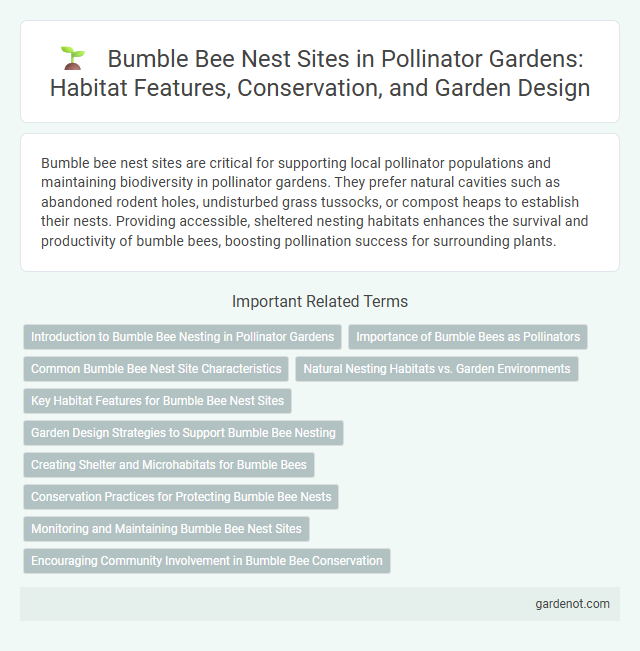Bumble bee nest sites are critical for supporting local pollinator populations and maintaining biodiversity in pollinator gardens. They prefer natural cavities such as abandoned rodent holes, undisturbed grass tussocks, or compost heaps to establish their nests. Providing accessible, sheltered nesting habitats enhances the survival and productivity of bumble bees, boosting pollination success for surrounding plants.
Introduction to Bumble Bee Nesting in Pollinator Gardens
Bumble bee nests in pollinator gardens provide essential habitat for these vital pollinators, supporting biodiversity and crop pollination. Nest sites are often found underground in abandoned rodent burrows or in dense grass tussocks, requiring undisturbed soil and natural ground cover. Incorporating native plants and maintaining undisturbed areas enhances nesting success and promotes healthy bumble bee populations.
Importance of Bumble Bees as Pollinators
Bumble bee nests play a crucial role in supporting pollination, enhancing biodiversity by facilitating the reproduction of various flowering plants. These pollinators are highly efficient due to their ability to forage in cooler temperatures and lower light conditions, making them indispensable for early-season crops and wild flora. Protecting bumble bee nesting sites ensures sustained agricultural productivity and ecosystem health.
Common Bumble Bee Nest Site Characteristics
Common bumble bee nest sites are typically found in abandoned rodent burrows, dense grass tussocks, or under piles of leaf litter and compost. These locations provide insulation, moisture control, and protection from predators, creating an ideal microhabitat for colony development. Nesting underground or at ground level ensures stable temperatures and easy access to nearby flowering plants, essential for foraging and nurturing larvae.
Natural Nesting Habitats vs. Garden Environments
Bumble bee nest sites thrive best in natural nesting habitats such as abandoned rodent burrows, tussock grasses, and decaying wood, offering shelter and stable microclimates crucial for colony development. Garden environments can supplement these needs when they incorporate features like undisturbed soil patches, dense leaf litter, and hedgerows that mimic natural conditions. Creating a pollinator garden with such elements enhances bumble bee nesting success by providing essential resources beyond just floral abundance.
Key Habitat Features for Bumble Bee Nest Sites
Bumble bee nest sites require well-drained, undisturbed soil with dense vegetation for shelter and temperature regulation. Key habitat features include grassy tussocks, loose soil, and proximity to flowering plants for foraging resources. Presence of abandoned rodent burrows and leaf litter enhances nesting opportunities, supporting colony establishment and growth.
Garden Design Strategies to Support Bumble Bee Nesting
Incorporate undisturbed areas with dense vegetation and natural ground cover to provide ideal nesting sites for bumble bees. Design garden layouts that include patches of bare soil, rotten wood, and tussocks of grass to mimic their preferred nesting habitats. Select native plants that bloom sequentially to ensure continuous forage near nesting locations, promoting colony growth and sustainability.
Creating Shelter and Microhabitats for Bumble Bees
Creating shelter and microhabitats for bumble bees within a pollinator garden significantly boosts their nesting opportunities and survival rates. Incorporating features such as undisturbed soil patches, thick mulch layers, and dense vegetation provides essential cover and thermal regulation for bumble bee nests. Natural materials like leaf litter, hollow stems, and abandoned rodent burrows also enhance microhabitat diversity, supporting various bumble bee species throughout their life cycles.
Conservation Practices for Protecting Bumble Bee Nests
Ensuring the preservation of bumble bee nest sites involves maintaining undisturbed, well-drained areas with dense vegetation such as meadow grasses or leaf litter that provide natural shelter. Conservation practices prioritize avoiding soil disruption and minimizing pesticide use within and near nest habitats to enhance colony survival and reproduction. Creating buffer zones with diverse floral resources supports the entire bumble bee lifecycle, promoting population stability and ecosystem health.
Monitoring and Maintaining Bumble Bee Nest Sites
Effective monitoring of bumble bee nest sites involves regular observation to track colony health and activity, using non-intrusive methods such as remote cameras or periodic visual checks. Maintaining optimal conditions requires preserving native flora, ensuring availability of nectar and pollen sources, and protecting the area from pesticides and habitat disturbances. Data gathered supports adaptive management strategies to enhance nest site sustainability and promote pollinator population stability.
Encouraging Community Involvement in Bumble Bee Conservation
Creating bumble bee nest sites in community gardens enhances local biodiversity and supports pollinator populations essential for ecosystem health. Engaging residents through workshops and citizen science programs fosters awareness and active participation in bumble bee conservation efforts. Providing resources such as nesting boxes and native floral plants encourages sustainable habitat development, empowering communities to contribute to pollinator protection.
Bumble bee nest site Infographic

 gardenot.com
gardenot.com